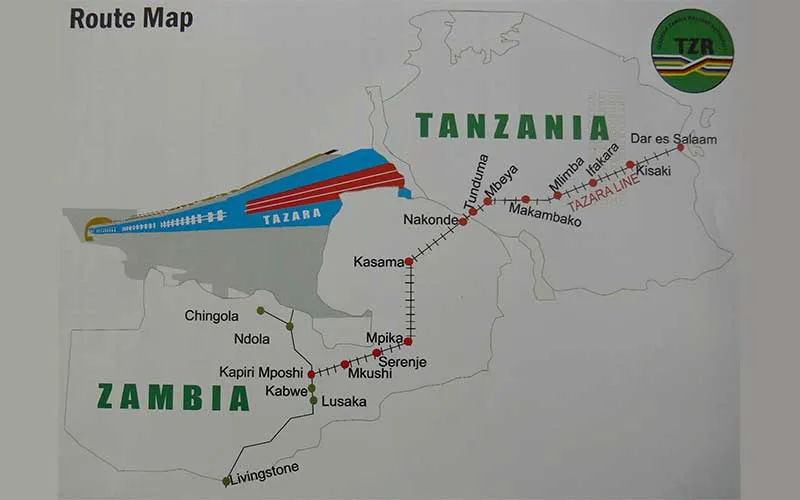The Tanzania-Zambia Railway Authority (TAZARA) is on the verge of a significant transformation, thanks to a $1.4 billion investment secured through a 30-year concession. This revitalization, aimed at modernizing the railway’s infrastructure, acquiring new locomotives, and enhancing operational efficiency, is poised to have a profound impact on regional tourism. While the project will improve trade and transport, its implications for tourism—particularly in Zambia—are substantial. Positioned as a gateway between Eastern and Southern Africa, Zambia stands to benefit immensely from TAZARA’s rejuvenation, fostering cross-border tourism and reinforcing the objectives of the African Continental Free Trade Agreement (AfCFTA).
Zambia: A Strategic Tourism Hub
Zambia’s central location makes it a crucial node for regional travel, connecting the tourism-rich landscapes of East Africa with the diverse offerings of Southern Africa. The modernized TAZARA will provide a seamless, efficient link between Tanzania’s bustling tourism industry—anchored by the Serengeti, Zanzibar, and Mount Kilimanjaro—and Zambia’s world-renowned attractions such as Victoria Falls, South Luangwa National Park, and Lower Zambezi.
This development strengthens Zambia’s position as a transit and destination hub, allowing tourists to explore both Eastern and Southern Africa with greater ease. The improved railway infrastructure will encourage multi-destination tourism, where travelers can visit multiple countries in a single trip without the hassle of expensive flights or lengthy road journeys.
Encouraging Borderless Tourism
One of the most significant advantages of TAZARA’s revitalization is the promotion of borderless tourism. The enhanced connectivity between Tanzania and Zambia will make cross-border travel more convenient, allowing for smoother immigration processes and encouraging longer, more extensive travel itineraries.
With the AfCFTA framework advocating for reduced travel restrictions and improved intra-African trade, TAZARA’s modernization aligns with this vision by offering a reliable transport system that complements open-border policies. This could lead to the introduction of regional tourism packages, such as railway safari circuits that incorporate Tanzania’s Serengeti, Zambia’s game reserves, and beyond.
Increased Accessibility and Affordability
For many budget-conscious travelers, particularly backpackers and adventure tourists, the cost of air travel within Africa remains prohibitive. The enhanced railway service provides an affordable and scenic alternative, making Zambia more accessible to regional and international tourists.
Moreover, the acquisition of 32 new locomotives and 763 wagons will improve efficiency, reducing travel times by up to 50%. This means that tourists can reach their destinations faster and more comfortably, making railway travel a competitive option against air and road transport.
Boosting Regional Tourism Infrastructure
With an anticipated 20% increase in passenger numbers, reaching 3.6 million annually, the demand for supporting tourism infrastructure in Zambia will rise. Hoteliers, tour operators, and local businesses will need to adapt to cater to an influx of travelers arriving by train.
The railway’s expansion will also stimulate investment in accommodation facilities near key railway stations, leading to the growth of secondary tourism hubs along the corridor. Local tour operators can capitalize on this by developing tailored packages that integrate railway travel with cultural and wildlife experiences in Zambia and neighboring countries.
Comparative Advantage with AfCFTA
The AfCFTA, designed to boost intra-African trade and investment, provides an ideal framework for maximizing the potential of TAZARA’s rehabilitation. By facilitating smoother movement of people and goods, AfCFTA supports the development of regional tourism corridors.
Compared to air travel, which remains fragmented due to high tariffs and restrictive bilateral agreements, rail travel under a unified economic zone offers a more consistent and predictable mode of transport. TAZARA’s transformation gives Zambia a comparative advantage by positioning it as a logistics and tourism hub where travelers and traders alike can move seamlessly between regions.
Zambia can leverage this connectivity to promote cross-border tourism initiatives, such as transnational wildlife safaris linking parks across Tanzania, Zambia, Zimbabwe, and Botswana. Additionally, heritage and cultural tourism can thrive as rail corridors make it easier for tourists to explore historical sites and indigenous communities across multiple countries.
Sustainability and Eco-Tourism Gains
Rail travel is inherently more sustainable compared to road and air transport, producing significantly lower carbon emissions. As global tourism trends shift towards eco-conscious travel, TAZARA’s modernization aligns with this movement by offering an environmentally friendly alternative.
Zambia, home to some of Africa’s most pristine natural landscapes, can position itself as a leader in sustainable tourism by integrating railway travel into eco-tourism packages. From national park visits to river safaris, the renewed railway system can serve as a backbone for green travel initiatives.
Conclusion: A Catalyst for Tourism Growth
The $1.4 billion investment in TAZARA is more than just an infrastructure upgrade; it is a transformative project that will reshape regional tourism in Eastern and Southern Africa. For Zambia, the railway’s modernization presents an opportunity to position itself as a leading travel hub, bridging East and Southern Africa and encouraging seamless, borderless tourism.
By improving accessibility, affordability, and sustainability, the revitalized railway will unlock new opportunities for tour operators, travel agents, and local businesses. As the AfCFTA continues to break down barriers to intra-African travel, Zambia’s strategic advantage as a tourism node will only grow stronger, ensuring that it remains a key player in Africa’s evolving travel landscape.


